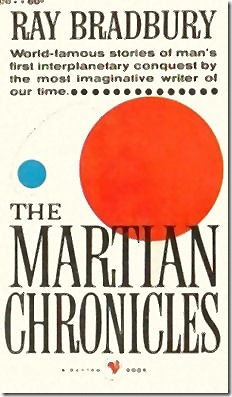 Allegory: A figurative work in which a surface narrative carries a secondary, symbolic or metaphorical meaning.
Allegory: A figurative work in which a surface narrative carries a secondary, symbolic or metaphorical meaning.
The Martian Chronicles, the 11th book by Bradbury that I’ve read this month is not really a novel and is more than a collection of short stories.
It is not a novel because it does not have the plot of a novel or even a unifying theme. It is a collection of stories about an Allegorical planet Mars that have an overall chronology, but lack a single protagonist or consistent central idea.
Mars is never the planet Mars in these stories. Mars always represents Waukegan Illinois, or the western frontier, or the evolution of mankind, or a grand dream, but Mars is only Mars in the sense that it provides the allegorical element for a statement on the human condition. The Martians, when they appear are not aliens, but symbols of human ideas.
Viewed as allegory, The Martian Chronicles is a deep investigation into the human spirit using images, and memes that appeared in the pages of the science fiction pulps of the 1930s and 40s. Because of this transcendental treatment of such a tawdry literary form, The Martian Chronicles has become a great piece of literature quite by accident. Bradbury was known only as a writer that appeared on the pages of Planet Magazine and Weird Tales and would have been known as a better than average writer of odd stories until the Martian Chronicles was recognized as been much more than it should have been. After the Martian Chronicles, Bradbury was treated seriously as a great American writer.
The ideas in the Martian Chronicles are fragmented and do not always fit together. They were written and published separately and sold to SF magazines. They are pulled together with short interstitial chapters that set the stage or attempted to unify the themes of the book. Separately the stories are each an interesting story, if one understands them to be fantasy and not scientific. Bradbury surely knew that Mars was cold, dead and airless. He chose to make his Mars closer to Edgar Rice Burroughs’ Barsoom than a scientifically accurate reality. Reading the stories can jar you back and forth from one idea to another. If you try to force the variety of ideas, themes and images into a an overall unity, it distracts from the enjoyment of the book.
I now read the Martian Chronicles as separate stories. Some are good, some not so. I find it difficult to see the book as a novel, though. One of the stories, There Will Come Soft Rains, I find annoying as it doesn’t fit the rest of the book. It has no characters and is just a vignette, yet it is one of Bradbury’s most often anthologized pieces, because it does contain some of his most powerful imagery.
The copy of The Martian Chronicles that I have was published in 1962 and it is quite probably that I read it first when I was eleven or twelve years old. I read it a few more times, but I can remember being frustrated with the book because so many of the stories were so obviously not anything like Science Fiction. I found some of them implausible, and I was not able to suspend disbelief. Now, I see the stories for what they are and what they are meant to be. Once you get the idea that Mars is never really Mars the book is a much better read.